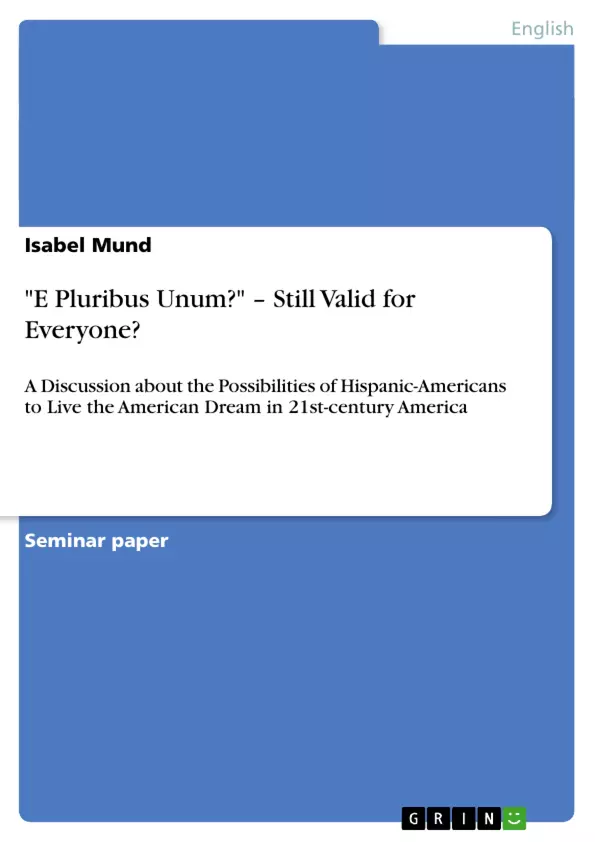Diese Hausarbeit beschäftigt sich mit dem American Dream und seiner Anwendbarkeit auf die aktuelle Generation der Hispanics im 21. Jahrhundert. Die Hausarbeit geht von der Entstehung des American Dream in der amerikanischen Geschichte aus und betrachtet die aktuellen Möglichkeiten für die spanische 'Minderheit', den amerikanischen Traum heute zu leben. *** This term paper deals with the American Dream and its validity for the contemporary Hispanics in 21st-century America. The term paper outlines the development of the American Dream and its origins in the history of the United States of America. Moreover, it considers and discusses the current possibilities of the Hispanic minority to live the American Dream today.
Inhaltsverzeichnis (Table of Contents)
- The American Dream: A Fundamental Concept
- The Hispanics - A Case Study
- The Position of Hispanics in American Society
- Education and Preconditions
- The American Dream for Hispanics: A Reality?
Zielsetzung und Themenschwerpunkte (Objectives and Key Themes)
This essay examines the possibilities for Hispanic-Americans to live the American Dream in 21st-century America. It uses the Hispanic population as a case study to explore the factors that influence the accessibility of the American Dream for minority groups.- The definition and evolution of the American Dream
- The socio-economic status and position of Hispanics in American society
- The role of education in accessing the American Dream
- The prevalence and potential for Hispanics to achieve the American Dream
- The potential disparities in access to the American Dream between different minority groups
Zusammenfassung der Kapitel (Chapter Summaries)
- The American Dream: A Fundamental Concept: This chapter introduces the concept of the American Dream and its historical evolution, tracing its roots from the 1880s to the post-World War II era. It highlights the traditional view of the American Dream as economic success attainable through hard work and individual initiative.
- The Hispanics - A Case Study: This chapter introduces the Hispanic population as the largest minority group in the USA, outlining their demographic characteristics and highlighting their socio-economic status. It explores data that suggests a relatively positive position of Hispanics in the American society, with participation in the labor force and some cultural assimilation.
- The Position of Hispanics in American Society: This chapter delves deeper into the socio-economic status of Hispanics in America, comparing their educational attainment and professional positions with the general population. It reveals disparities, particularly in educational levels and access to higher-paying jobs.
- Education and Preconditions: This chapter explores the link between poverty and educational success, citing a study by Susan B. Neuman that suggests a correlation between low-income neighborhoods and limited access to educational resources. It argues that the lack of education can act as a barrier to economic success, further impeding Hispanics' access to the American Dream.
Schlüsselwörter (Keywords)
This essay explores the American Dream, specifically focusing on the experiences of Hispanic-Americans. It examines key concepts such as socioeconomic status, education, access to resources, and the role of individual effort in achieving the American Dream. The essay delves into the factors that contribute to the potential disparities in access to the American Dream between different minority groups, highlighting the complex interplay between social structures and individual aspirations.- Quote paper
- Isabel Mund (Author), 2013, "E Pluribus Unum?" – Still Valid for Everyone?, Munich, GRIN Verlag, https://www.grin.com/document/233368



